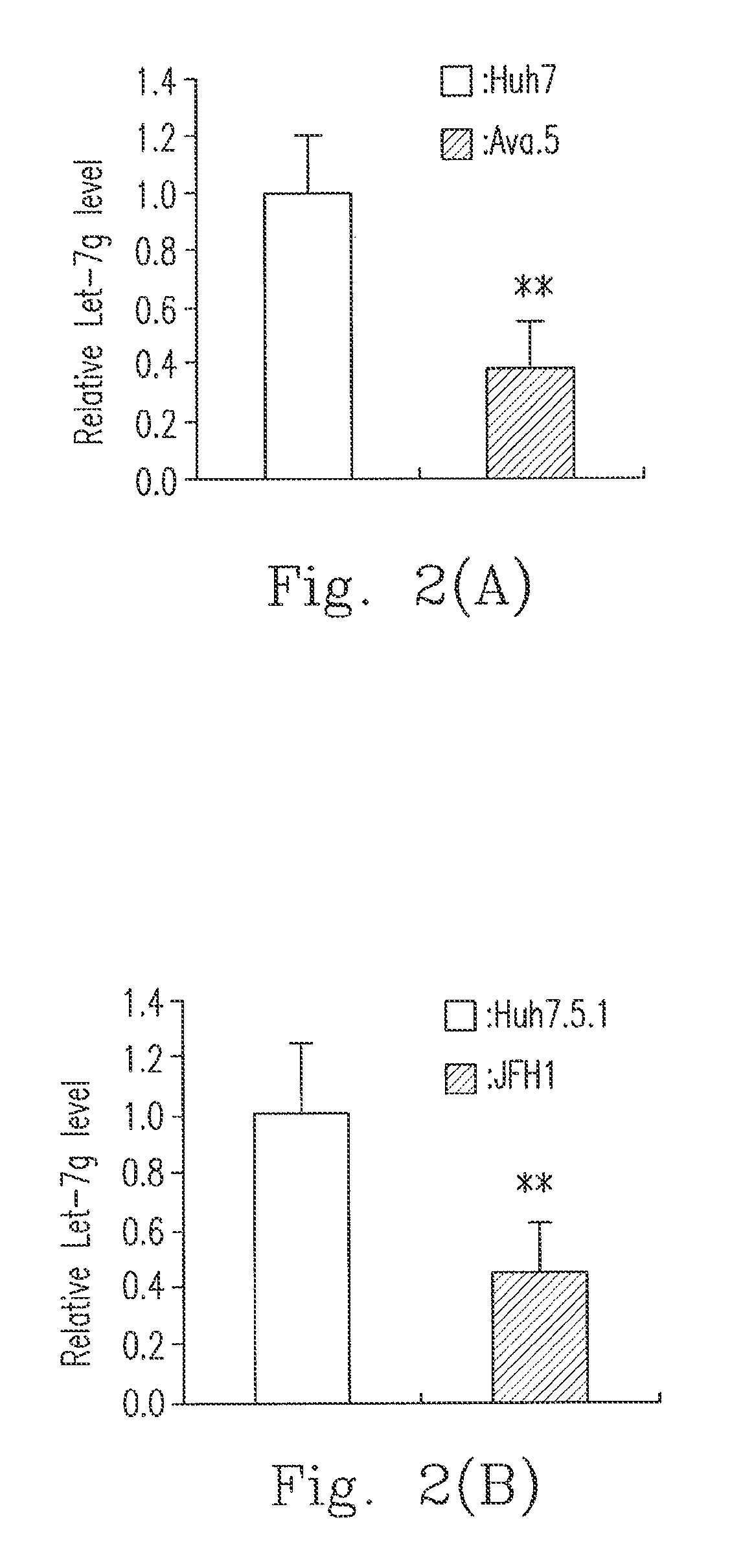Use of Let-7g to down regulate NS5B gene, core protein and viral load of hepatitis C virus
a technology of hepatitis c virus and let7g, which is applied in the field of use of let7g, can solve the problems of severe side effects and severe impact on the daily life of patients, and achieve the effect of reducing viral load and inhibiting virus replication
- Summary
- Abstract
- Description
- Claims
- Application Information
AI Technical Summary
Benefits of technology
Problems solved by technology
Method used
Image
Examples
embodiment 1
[0021]The present invention uses the sequence of Ava.5 cells (no. AJ242654.1 in the gene bank) to make predictions. It is found that the miRNA Let-7g may be combined with position bearing nucleotides of No. 43-65 in the 5′untranslated region (5′UTR) of a genome of the HCV (please refer to FIG. 1(A)).
embodiment 2
[0022]For a further confirmation, the present invention constructs a Let-7g luciferase reporter plasmid capable of direct combination (hepatitis C virus 5′UTR-WT), and a Let-7g luciferase reporter plasmid lacking Let-7g combining sequences (hepatitis C virus 5′UTR-DEL). In FIG. 1(B), a Let-7g mimic (▪) or a negative control (NC) mimic, as well as a luciferase reporter plasmid for a hepatitis C virus 5′UTR-WT are transgened into Ava.5 cells carrying the genome of the hepatitis C virus. In FIG. 1(C), a Let-7g mimic along with a luciferase reporter plasmid of a hepatitis C virus 5′UTR-WT (□) or a hepatitis C virus 5′UTR-DEL (▪) together are transgened into Ava.5 cells carrying the genome of the hepatitis C virus. 48 hours later, the activity values of luciferases in the Ava cell values are determined, and a green luciferase protein (GFP) served as an internal control. The data in this embodiment was sampled from three trials and represented as the average±standard deviation of *P<0.05....
embodiment 3
[0025]In order to explore the relationship between Let-7g and an infection of HCV, the present invention detects expression levels of the Let-7g in a virus replicon and infected cells. In FIG. 2(A), the Huh7 and Ava.5 cells were cultured for 72 hours, and then the RNA was separated. In FIG. 2 (B), Huh7.5.1 cells were cultured for 24 hours and then cell-culture derived HCV infected cells JFH1 HCVcc were added, and then its RNA was separated 72 hours after the infection. We used quantitative real time PCR to detect the expression levels of the Let-7g, and used snU6B as an internal control. In addition, a Let-7g mimic or a negative control mimic (NC) was transfected into Ava.5 cells (please refer to FIG. 2 (C)) or infected cells JFH1 (please refer to FIG. 2 (D)), and its RNA was separated 72 hours after the infection. After that, we used quantitative real time PCR to detect expression levels of the NS5B protein of the HCV, and used glyceraldehyde-3-phosphate dehydrogenase (GAPDH) as an...
PUM
| Property | Measurement | Unit |
|---|---|---|
| quantitative real time PCR | aaaaa | aaaaa |
| CT | aaaaa | aaaaa |
| size | aaaaa | aaaaa |
Abstract
Description
Claims
Application Information
 Login to view more
Login to view more - R&D Engineer
- R&D Manager
- IP Professional
- Industry Leading Data Capabilities
- Powerful AI technology
- Patent DNA Extraction
Browse by: Latest US Patents, China's latest patents, Technical Efficacy Thesaurus, Application Domain, Technology Topic.
© 2024 PatSnap. All rights reserved.Legal|Privacy policy|Modern Slavery Act Transparency Statement|Sitemap



